How to Apply for an IPO (HDFC Bank )
In this session, we will learn step by step how to apply for IPOs through HDFC Bank net banking -all by using live examples.
Filling the application incorrectly is the number #1 reason for rejection of IPO application so make sure you watch this video completely and follow the instructions carefully.
As you know, there are two types of IPOs – Book Building and Fixed price.
Book building IPOs are the ones where there is a price range and investors are asked to place their bids at their best price
Fixed ones have just one price point.
Let’s start with the most common one:
Book building IPO
I will be applying for the IPO of HDFC Asset Management Company, who manages HDFC Mutual Funds. I am sure you would have heard about them.
Ok, lets get going…
First, let me login to my HDFC Bank net banking. Then on the left, hit the ‘Request’ tab. Scroll down a little and here is the “IPO Application” option.
Click on it and continue to the IPO system.
I am redirected to the HDFC Securities page. What you will find in this page is the list of all the open IPOs at the time. So if there are 5 IPOs open at the same time, you see them all listed here.
As of now there is just one IPO but different 3 separate applications – one for general public like you and me, other for their employees and third for HDFC’s shareholders.
I will select General.
Now we are at the order placement page.
Alright, start paying attention because you should know exactly what to fill in every field:
Select Investor Status as IND RETAIL, unless of course you are an HNI. HNI is “High Networth Individual, means someone with a lot of money.
As soon as I do that, I get a little pop-up.
This is basically a message saying that the amount equal to the IPO bid amount will be blocked in my bank account and will be debited from the bank account only if I receive an allocation. So if I do not get any allocation of share, the block is removed. If I do get the allocation, money will be debited from my account.
Bottom line is that the money stays in the account and there is not hassle of refund. It was a big problem until SEBI came up with this new process of applying for IPOs.
Before filling this form out, you need to check the lot size. The lot size of this IPO is 13 shares so that means I can only apply in the multiples of 13. 13, 26, 39, 52 ….all the way to 169- which is the upper cutoff. (because max amount can not be more than 2 lakh)
Now, let’s see the price band. It is between 1095 to 1100. It means my bid has to stay in this range.
Bid Details –
I can enter up to 3 bids.
Notice when I give 13 that is 1 lot and price as 1095, system automatically calculates the total amount as 14,235 rupees- that’s the price of 1 lot.
Let’s say I want to enter two more bids. Second bid of 2 lots, meaning 26 shares, and the price for this bid is , let’s say, 1096. Notice how the application amount just went up?
Let’s see what happens when I place the third bid at the cut off price. It automatically picks up the highest price that is 1100.
Notice that the application amount will always be the highest of the 3 bids. It will not be the total of all three bids because at the end of the day, only 1 bid will be accepted. It’ a very common misconception.
Alright, I hope you’re clear how the bids work. If you have any confusion about how bids are placed or strategies for getting IPO allocations, do checkout the video linked in the description below. We have covered a lot of commonly asked questions about IPOs.
OK, since I want to give my application the best chance of getting allocated, I will just place the bid for 1 lot at the cut off price.
Done.
Moving on…
This is the applicant details section. The first applicant’s name and PAN# are already filled out. If you want, you can add second or third applicant as well but that is completely optional.
Next is the Date of Birth. Fill it out real quick.
Father’s/Husband’s name is optional so I will just skip it.
OK, this is the most important section of the application because here’s where most people make mistakes. So, pay close attention.
You need a DEMAT account in order to apply for an IPO. Why? Because it would be like asking someone electronically transfer money to you when you don’t have a bank account. Where will they send the money?
DEMAT account is like a bank account for your shares. That is where your shares are stored. If you get the IPO allocation, this is the account where your shares will be sent.
Now, some of you ask “ sir, I have an account with Zerodha or Sharekhan or Kotak secuities…is that my demat account?” If you’re asking this question, it means you don’t understand the difference between DEMAT and Trading account. Do checkout the video in the description below that explains with a live example.
Anyway, you will need your Demat account number.
If you are a Zerodha customer, it’s easy.
Just go to Kite-> Backoffice-> Profile -> and there on the right hand side check out the “DP ID FOR IPO APPLICATION”. That’s your DEMAT account. OK, got it?
For others, just call your broker, tell them that you’re applying for an IPO and that you need to know 2 things:
A-> Who is the provider of DEMAT account – NSDL or CDSL? These are the only two providers of demat accounts in India.
And B-> What’s your DEMAT a/c number
Your DEMAT account will be a 16 digit number which is formed by putting together two IDs: Depository ID (8 digits) and Beneficiary ID (8 digits).
Depository ID is the ID of your broker. Sharekhan, etc,,.
Client ID is your ID with that broker.
If your broker has DEMAT account with CDSL, it would look something like this. All 16 digits will be numbers.
If account with NSDL, first two would be letters “IN” and remaining 14 will be numbers.
Ok, now that you have your demat account number and you know who provides it, you have to enter the information out very very carefully.
Depository is the provider of your DEMAT account.
For my Zerodha account it is CDSL. So, I pick it from the drop down. Next field is the DP name, DP means Depository Participant, which is just a fancy term for broker. My broker is Zerodha.
You will notice that when you pick CDSL, the DP ID field gets grayed out. It is because for CDSL, the whole DEMAT account number – the 16 digits- has to be filled out in the “Beneficiary Account number” field. Let me do that.
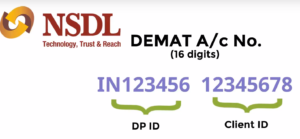
From here onwards, it will be a very easy. The Bank details will be automatically populated, as you can see. Just hit “proceed”
You will get this little confirmation message,…let me click “confirm”
Nothing is happening? Why?
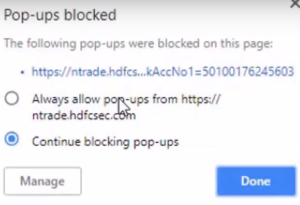
If you are having the same problem, don’t worry; your popup blocker is preventing the next screen to show up. All you have to do it is turn OFF your Pop up blocker and retry. This is a very common mistake guys, so make sure your pop up bloker is turned off even before you start the application.
After that, you will get this long disclaimer. Just scroll down and accept.
Ok ..now…it says “There is a cash short fall of Rs 14300 for this order”. Don’t worry …all this message is asking for permission to block funds for the IPO.
No problem, I will hit submit.
Done !
Your bid has been successfully placed.
It means your IPO application has been submitted. Awesome.
Follow the steps mentioned in this video and if you have any question, feel free to ask in the comments section.
Howdy!
If you’re here for the first time, let’s get introduced.
VRD Nation is India’s premier stock market training institute and we (Team VRD Nation) are passionate about teaching each and every aspect of investing and trading.
If you’re here for the first time, don’t forget to check out “Free Training” section where we have tons of free videos and articles to kick start your stock market journey.
Also, we got two awesome YouTube channels where you can continue the learning process.
Must-Read Articles
How to Apply for an IPO (HDFC Bank )
In this session, we will learn step by step how to apply for IPOs through HDFC Bank net banking -all by using live examples.
Filling the application incorrectly is the number #1 reason for rejection of IPO application so make sure you watch this video completely and follow the instructions carefully.
As you know, there are two types of IPOs – Book Building and Fixed price.
Book building IPOs are the ones where there is a price range and investors are asked to place their bids at their best price
Fixed ones have just one price point.
Let’s start with the most common one:
Book building IPO
I will be applying for the IPO of HDFC Asset Management Company, who manages HDFC Mutual Funds. I am sure you would have heard about them.
Ok, lets get going…
First, let me login to my HDFC Bank net banking. Then on the left, hit the ‘Request’ tab. Scroll down a little and here is the “IPO Application” option.
Click on it and continue to the IPO system.
I am redirected to the HDFC Securities page. What you will find in this page is the list of all the open IPOs at the time. So if there are 5 IPOs open at the same time, you see them all listed here.
As of now there is just one IPO but different 3 separate applications – one for general public like you and me, other for their employees and third for HDFC’s shareholders.
I will select General.
Now we are at the order placement page.
Alright, start paying attention because you should know exactly what to fill in every field:
Select Investor Status as IND RETAIL, unless of course you are an HNI. HNI is “High Networth Individual, means someone with a lot of money.
As soon as I do that, I get a little pop-up.
This is basically a message saying that the amount equal to the IPO bid amount will be blocked in my bank account and will be debited from the bank account only if I receive an allocation. So if I do not get any allocation of share, the block is removed. If I do get the allocation, money will be debited from my account.
Bottom line is that the money stays in the account and there is not hassle of refund. It was a big problem until SEBI came up with this new process of applying for IPOs.
Before filling this form out, you need to check the lot size. The lot size of this IPO is 13 shares so that means I can only apply in the multiples of 13. 13, 26, 39, 52 ….all the way to 169- which is the upper cutoff. (because max amount can not be more than 2 lakh)
Now, let’s see the price band. It is between 1095 to 1100. It means my bid has to stay in this range.
Bid Details –
I can enter up to 3 bids.
Notice when I give 13 that is 1 lot and price as 1095, system automatically calculates the total amount as 14,235 rupees- that’s the price of 1 lot.
Let’s say I want to enter two more bids. Second bid of 2 lots, meaning 26 shares, and the price for this bid is , let’s say, 1096. Notice how the application amount just went up?
Let’s see what happens when I place the third bid at the cut off price. It automatically picks up the highest price that is 1100.
Notice that the application amount will always be the highest of the 3 bids. It will not be the total of all three bids because at the end of the day, only 1 bid will be accepted. It’ a very common misconception.
Alright, I hope you’re clear how the bids work. If you have any confusion about how bids are placed or strategies for getting IPO allocations, do checkout the video linked in the description below. We have covered a lot of commonly asked questions about IPOs.
OK, since I want to give my application the best chance of getting allocated, I will just place the bid for 1 lot at the cut off price.
Done.
Moving on…
This is the applicant details section. The first applicant’s name and PAN# are already filled out. If you want, you can add second or third applicant as well but that is completely optional.
Next is the Date of Birth. Fill it out real quick.
Father’s/Husband’s name is optional so I will just skip it.
OK, this is the most important section of the application because here’s where most people make mistakes. So, pay close attention.
You need a DEMAT account in order to apply for an IPO. Why? Because it would be like asking someone electronically transfer money to you when you don’t have a bank account. Where will they send the money?
DEMAT account is like a bank account for your shares. That is where your shares are stored. If you get the IPO allocation, this is the account where your shares will be sent.
Now, some of you ask “ sir, I have an account with Zerodha or Sharekhan or Kotak secuities…is that my demat account?” If you’re asking this question, it means you don’t understand the difference between DEMAT and Trading account. Do checkout the video in the description below that explains with a live example.
Anyway, you will need your Demat account number.
If you are a Zerodha customer, it’s easy.
Just go to Kite-> Backoffice-> Profile -> and there on the right hand side check out the “DP ID FOR IPO APPLICATION”. That’s your DEMAT account. OK, got it?
For others, just call your broker, tell them that you’re applying for an IPO and that you need to know 2 things:
A-> Who is the provider of DEMAT account – NSDL or CDSL? These are the only two providers of demat accounts in India.
And B-> What’s your DEMAT a/c number
Your DEMAT account will be a 16 digit number which is formed by putting together two IDs: Depository ID (8 digits) and Beneficiary ID (8 digits).
Depository ID is the ID of your broker. Sharekhan, etc,,.
Client ID is your ID with that broker.
If your broker has DEMAT account with CDSL, it would look something like this. All 16 digits will be numbers.
If account with NSDL, first two would be letters “IN” and remaining 14 will be numbers.
Ok, now that you have your demat account number and you know who provides it, you have to enter the information out very very carefully.
Depository is the provider of your DEMAT account.
For my Zerodha account it is CDSL. So, I pick it from the drop down. Next field is the DP name, DP means Depository Participant, which is just a fancy term for broker. My broker is Zerodha.
You will notice that when you pick CDSL, the DP ID field gets grayed out. It is because for CDSL, the whole DEMAT account number – the 16 digits- has to be filled out in the “Beneficiary Account number” field. Let me do that.

From here onwards, it will be a very easy. The Bank details will be automatically populated, as you can see. Just hit “proceed”
You will get this little confirmation message,…let me click “confirm”
Nothing is happening? Why?

If you are having the same problem, don’t worry; your popup blocker is preventing the next screen to show up. All you have to do it is turn OFF your Pop up blocker and retry. This is a very common mistake guys, so make sure your pop up bloker is turned off even before you start the application.
After that, you will get this long disclaimer. Just scroll down and accept.
Ok ..now…it says “There is a cash short fall of Rs 14300 for this order”. Don’t worry …all this message is asking for permission to block funds for the IPO.
No problem, I will hit submit.
Done !
Your bid has been successfully placed.
It means your IPO application has been submitted. Awesome.
Follow the steps mentioned in this video and if you have any question, feel free to ask in the comments section. Alright guys take care.

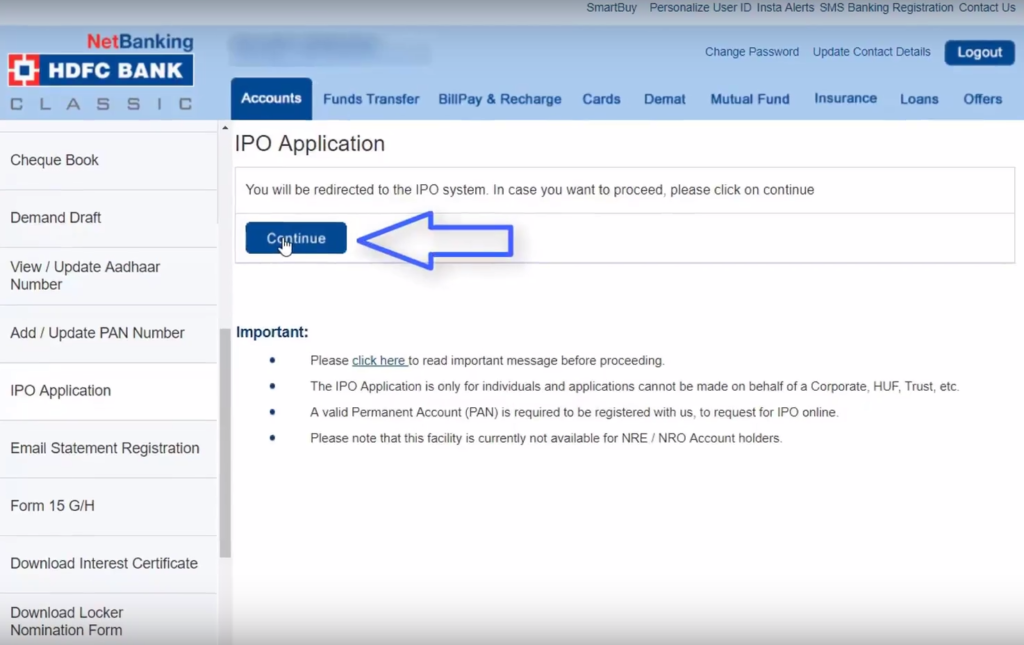

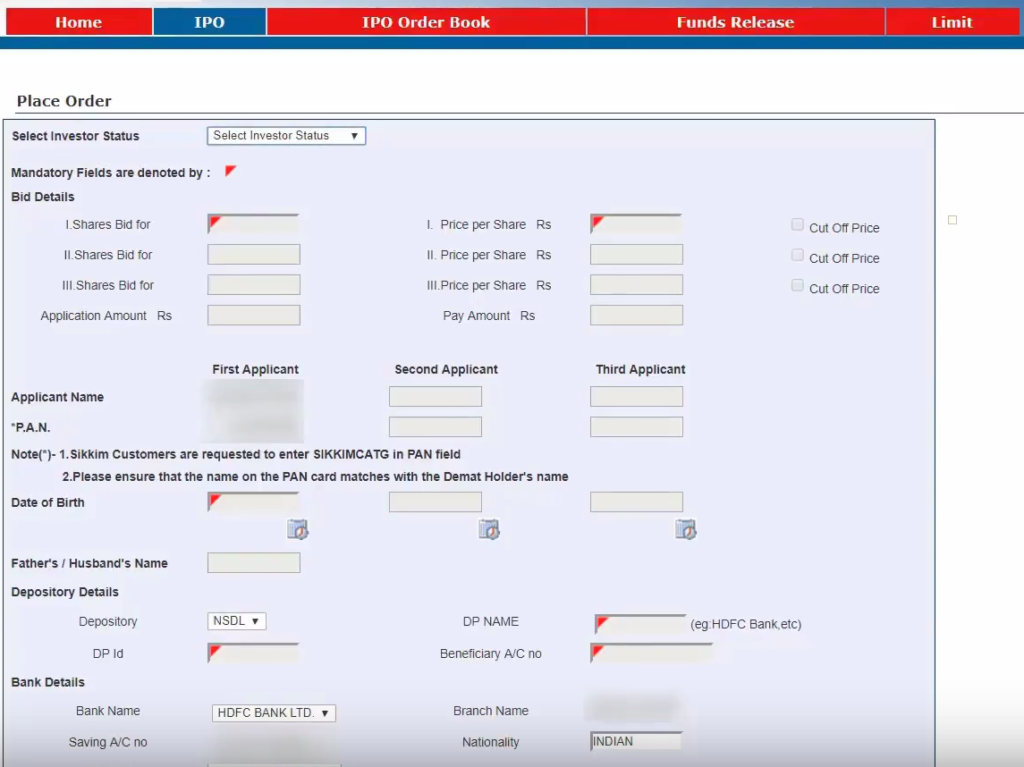
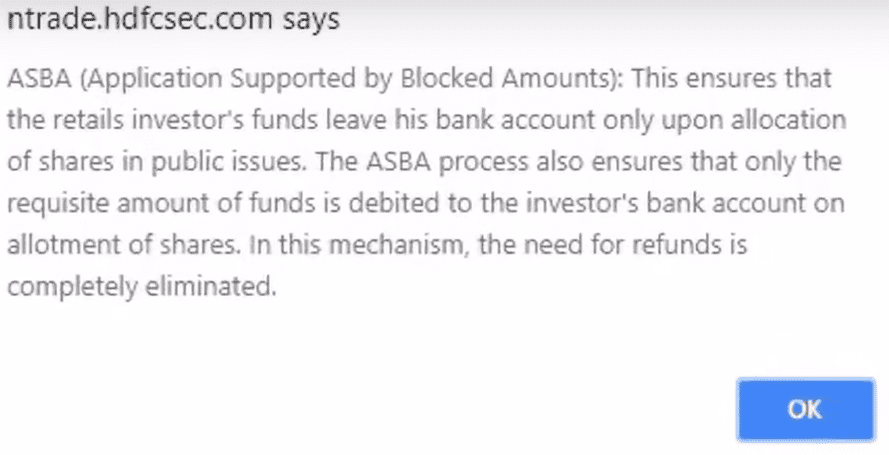
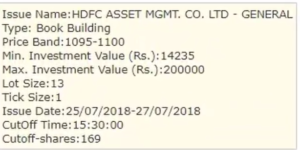


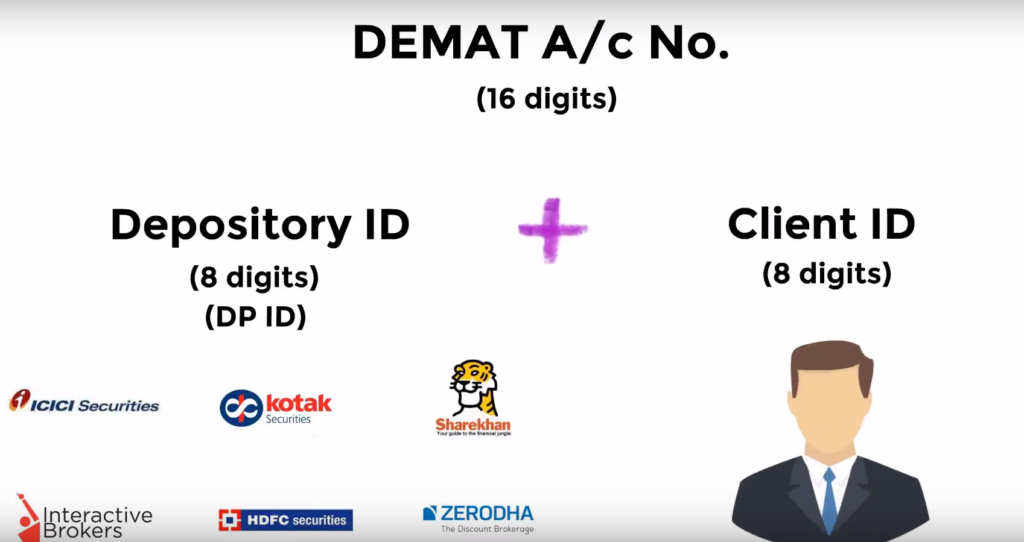
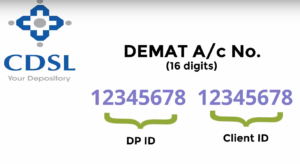


















i want to apply for an ipo through my cousin’s HDFC bank account but he doesn’t have demat account. His name is autofilled in the application details. How can i remove his name.
Please help me Sir
Hi, you can apply to IPO only with your own bank account. You cannot apply with others bank account on your name.